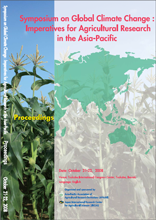Pakistan: Research on Impacts of Climate Change and Adaptation Strategies

Pakistan has a population of 170 million and is located in South-Asia between 24° and
37° N latitude and 61° and 75° longitude covering an area of 88.2 million hectares. It is
endowed with diverse agro-climate, topography, and culture. Three of the major mountain
ranges of the world, namely Himalaya, Karakoram, and Hindu-Kush (HKH), border the north
followed by plateaus, plains and coastal areas in the south... The climatic variability is
expressed by humid zones in the north-east to hyper-arid in the south-west and west. Major
part of the agricultural and range lands lie in the arid to hyper-arid zones of the country.
The research on climate change in Pakistan is in its early stages with initial focus on
studies relating to the potential impact of climate change on agriculture production and natural
resource base. Several projects have been initiated in collaboration with international
institutions like APN, ICIMOD, UNEP, START, etc. The focus of these initiatives is on the
impact of climate change on the water resources (glacier melt, rainfall), temperature,
agriculture, environment etc. Recently an inventory of glaciers and glacial lakes in the HKH
region of Pakistan has been completed and a Global Change Impact Study Center established
to undertake research on the impacts of climate change in a systematic manner.
The ongoing studies focus on resource inventories/vulnerability assessment and
simulation modeling of the potential impacts on water resources, agriculture production,
forest ecosystems and socioeconomic conditions. The major findings of these studies are
summarized below.
There are strong indications that climate change is likely to impact Pakistan’s
agriculture in at least two ways. The Indus basin depends heavily on the glacier-melt that act
as a reservoir, capturing snow and rains, holding water and releasing it into the rivers which
feed the irrigation system. With the increase in global temperature there will be increase in the
melting of glaciers for the next 50 years, during which time the flows in the rivers are
expected to increase. Nine out of the ten General Circulation Models used by the IPCC
indicate that precipitation during summer monsoon will increase substantially but is likely to
be poorly distributed in time as well as in space; much of the additional rainfall is likely to be
in high-intensity storms. The National Communication on Climate Change has projected the
following major impacts on agriculture in Pakistan:
a. Shift in Spatial Boundaries of Crop Potential Areas: The global climate change
will affect the growing season length of crops due to higher temperature and
reduced soil moisture; alter the stages of plant growth with accelerated growth
early in the season, affecting the quantity and quality of biomass; affect crop pests
and diseases; and entail spatial shifts in potential areas of agricultural crops.
b. Changes in Productivity: The quality and quantity of crop yield will be affected
by climate change in two ways: a) direct effects from changes in temperature,
water balance, CO2 concentrations and extreme events; and b) indirect effects
through changes in distribution, frequency and severity of pest and disease
outbreaks, incidence of fire, weed infestation, or through changes in soil
properties; c. Changes in Water Availability: The increase in temperature has direct effect on
crop evapotranspiration and loss of soil moisture. The increase in crop
evapo-transpiration when combined with decrease in precipitation in the rain-fed
environments resulted into decrease in crop evapo-transpiration due to limited
availability and use of soil moisture by crops;
d. Changes in Cropping Pattern: A rise in temperature and reduction in rainfall
could increase the net irrigation water requirement of crops, thereby forcing
farmers to make changes in cropping patterns to adjust to climate change.
e. Changes in Land Use Pattern: The global warming, climatic extremes and CO2
concentrations would lead towards changes in land use systems due to changes in
the growing season of crops. The climatic changes in arid climates would result
in increased salinity and/or water logging; which would certainly demand for
integration of forestry and aquaculture with the crop based farming systems.
| Date of issued | |
|---|---|
| Creator | Muhammad E. Tusneem |
| Subject |
Research on Climate Change Pakistan APAARI/JIRCA Symposium |
| Publisher | Japan International Research Center for Agricultural Sciences |
| Available Online | |
| Issue | 2008 |
| spage | 76 |
| epage | 84 |
| Rights | Japan International Research Center for Agricultural Sciences |
| Language | eng |
